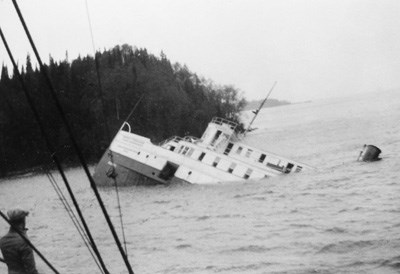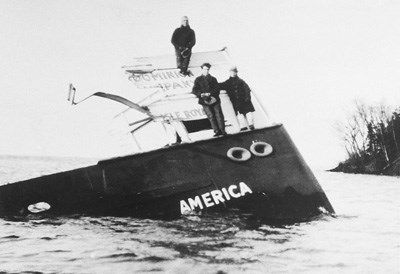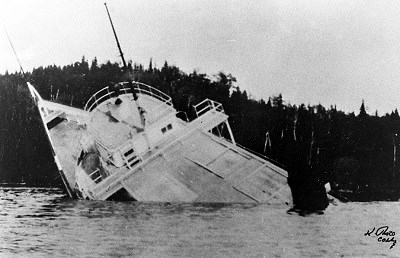Last updated: February 17, 2021
Article
SS America: Wreck Event and Survivor Accounts

Don Wolbrink Collection
Wreck Event
America's 1928 season began as many before it. There were no signs at all that this would be America's final season. America last steamed out of the Duluth Ship Canal on Wednesday, June 6, 1928, headed up the north shore and expected to touch at all the usual ports of call. From Grand Marais it headed toward Isle Royale to drop off a number of passengers in the darkness of early morning so they would not have to wait out the trip to Port Arthur. It went on to navigate around the northeast tip of the island, before landing at the customary Washington Harbor destinations the following day (Duluth News Tribune, June 7, 1928; Superior Evening Telegram, June 7, 1928; Holden interview with Capt. Stanley Sivertson, Duluth, Minn, in 1973 and with James R. Marshall, Pike Lake, Minn, in Oct. 1974, 1986).
Soon after clearing the dock in Washington Harbor, Capt. Smith turned command of America over to First Mate John Wick, with Fred Nelson at the wheel, and retired to his cabin behind the bridge. Five minutes later America thudded over a reef, bumping four times and tearing a small hole through its single bottom below the engine room on the starboard side. Mate John Wick was a new mate on America, having served previously as mate under Capt. Gus Ege on Jack of the Minnesota Atlantic Transit Co., popularly known as the "Poker Fleet." Wick quit MATCo because Capt. Ege would not recommend him for his own ship in the fleet (Ken Hafner interview with Capt. Duncan Schubert at Sault Ste. Marie, Mich. ca. 1977, copy in "Holden Collection").
-
Stanley Sivertson: Wreck of the America
Oral History 61: Stanley Sivertson 3 & 4
- Credit / Author:
- Dave Snyder: ISRO Archives.
- Date created:
- 03/03/1987

Patrie Collection
At first it seemed as though America's pumps could handle the inrushing water, but Chief Engineer Frank McMillan quickly reassessed the situation - America was going to sink. Meanwhile Capt. Smith returned to the bridge where he found Mate Wick ringing the ship's bell to alert all aboard of the disaster. Moments later Capt. Smith yelled, "Beach her! Beach her!" (Holden interviews with Marshall, 1974, 1986).
Capt. Smith remembered a small gravel beach nearby in the North Gap of Washington Harbor. It would be a good place to try to nose America ashore before she foundered in deep water. He ordered Fred Nelson to swing the wheel to point America directly toward the beach. Then another thud and America ground to a halt about 30 yards short of the beach that probably would have assured its imminent salvage, subsequent repair, and return to service.
Below deck in the engine room, Engineer McMillan ordered his crew to relieve boiler pressure and grease down everything in sight so America's power plant could be made readily functional when salvage work was completed. Water already had snuffed fireman Hans Fjorne's boiler fires (Holden interviews with Marshall, 1974, 1986).

Kenneth Thro Collection
America was carrying 31 crew and 16 passengers at the time of the accident (Duluth News Tribune June 9, 1928), shortly after slipping away from the Singer Hotel dock at Washington Island. It is possible Louis P. Hogstad, Manager of United States & Dominion Transportation Company, was aboard at the time of the accident and considered by Capt. Smith as a member of the crew ("Record of Casualties to Vessels." U.S. Treasury Department, p. 17, bound journal, copy in Canal Park Marine Museum collection).
The estimated value of the vessel was $100,000; the 55-ton cargo of miscellaneous merchandise was valued at $10,000. The amount of insurance on the hull was $60,000; disbursements was $40,000. The cargo was uninsured ("Record of Casualties to Vessels." U.S. Treasury Department, 17, bound journal, copy in Holden Collection).
Media Coverage / Survivor Accounts
The loss of the steamer America was covered in newspapers and journals ranging from the American and Canadian Lakehead port cities to Chicago and New York ("1928 Annual Report ." Lake Carriers' Association: 51-52; Canadian Railway and Marine World, ca. July 1928). First news of the wreck was carried over the wireless station affiliated with Singer's resort on Washington Island and sent to Duluth (Port Arthur News Chronicle June 7,8, 1928).
Duluth, Minn., June 7 - An old well-known passenger steamer, The America, was lying on the bottom of Lake Superior tonight under seventeen fathoms of water .... Reports of the sinking and rescue were still vague here early this evening. The only report so far came from the ship's purser, who said that the vessel struck a reef near Washington Harbor on Isle Royale at 3 a.m. and that the ship sank an hour and a half later.
The steamer Winyah was sent to take the rescued persons off the island. When the America left here yesterday morning she carried twenty passengers in addition to her crew of thirty (Chicago Herald and Examiner June 8, 1928).
Sinking of the steamer America off Isle Royale created a shortage of strawberries and fresh vegetables in Fort William and Port Arthur today. The Fitzsimmons Fruit company had ten tons of vegetables and fresh fruit on the boat.
These products would have been here for distribution today had the boat not gone down. However, it is reported that two trucks left Duluth at 5 o'clock this morning with a fresh supply. (Fort William Daily Times Journal June 8, 11, 1928).
In the most orderly manner, without any confusion whatsoever, 15 passengers and 30 members of the crew of the steamer America launched five boats and made for shore early Thursday morning according to the account of a member of the crew, Fred Nelson, wheelsman, who arrived here last night (Duluth News Tribune June 8, 1928).
Wheelsman Fred Nelson gave a detailed report of the events:
We were out in Washington Harbor about a half mile from the dock when the ship struck the reef .... This caused a loud noise which awakened most of the crew and passengers. Those who were not up when the crash occurred came on deck when the ships bells started ringing. Members of the crew went to cabin doors telling passengers and crew of the danger. The boat started sinking slowly. All five of the ship's life boats were launched. Members of the crew were assigned to take charge of these boats and everyone was taken off. Captain Edward C. Smith left on the last boat just before the entire ship was practically under water. There was no confusion while the life boats were being lowered. Everyone behaved wonderfully and the six women aboard, mostly members of the crew, were not a bit excited over the crash as all saw there was no danger. All of the five life boats reached Washington Harbor, a half mile from where the America hit the reef, without any trouble" (Duluth News Tribune June 8, 1928). Booth officials reported that John Wick, the first mate, was in charge of America at the time of the disaster, having relieved Capt. Smith just five minutes before the crash. These same officials were cautious about providing other particulars of the incident, pending their discussion with Capt. Smith in Grand Marais the night of June 8th (Duluth News Tribune June 8, 1928).
Passenger H. S. Cottier said after arriving in Port Arthur:
There is nothing to be seen of the old America now except the top of the mainmast and part of the pilot house sticking up out of the water ....
I left Duluth along with fourteen or fifteen other passengers for Port Arthur on Wednesday night .... We had an uneventful trip, and put in to Washington Harbor to let off two passengers for Isle Royale.
I understand that Captain Smith does not care to put in to Washington Harbor on the trip out of Duluth, but prefers to do so only on the return trip from Port Arthur. However, this time, in the middle of the night, he put in to Washington Harbor, and put his passengers off all right. Then we started out for open water again. It had not yet broken day, and we struck a reef just outside the harbor.
I was in bed and we got a fearful jar, and it woke me and everybody else up. I don't think anyone was hurt. We all dressed, and there were lots of boats to take us ashore. The ship began to settle and all we had to do was to get into the boats .... There was no panic whatever, and it was not until an hour later, when it was just breaking day, that the good ship sank almost out of sight in the waters of Lake Superior. It must have been shortly before four o'clock this morning, I should judge ....
Captain Smith stayed on his ship until to do so any longer was at the risk of his life. He saw everybody else ashore, sent all his crew away, and stayed on board himself, and alone until the ship was ready to sink. Then he, too, with evident reluctance, for he loved his ship, was put ashore himself.
Captain Smith sent the purser ashore with the first news of the disaster, and through the private telephone wire he got the news into Duluth. The purser was taken to the mainland, and proceeded back to Duluth, as did the captain later ....
We are all thankful ... to be alive and well today. I have lost some clothes and a few personal belongings. There were two men aboard who were going to Nipigon to fish the Nipigon river. They were on their way up from Detroit and they had a truck in the hold of the boat in which were their fishing tackle, rods, lines, and flies, and $500 in cash. They lost it all and did not continue on, but have returned to Duluth, and are now on their way to Detroit.
... The discipline was perfect .... There was complete order; there was no need for the cry "women and children first" because we had plenty of time. There was no real danger, and the passengers were given the first and every possible consideration" (Fort William Daily Times Journal June 8, 1928).
In a second account by Mr. Cottier, he said:
"The first we realized that there was anything amiss was when the America struck and was shaken from stern to stem. Hurried examinations were made by Mate Wick, and just a minute or so later we were aroused and told to make ready to get into life boats. We were told the boat was sinking. The boats were lowered and, without confusion, we got into them. We were taken to Washington Harbor, where Mr. Singer, proprietor of the resort there, made us comfortable. Captain Smith sent one of the crew to the wireless station and a message was sent to Duluth" (Port Arthur News Chronicle June 8, 1928).
The unfortunate loss of the steamer America has, for a time at least, removed from the run between Fort William and Duluth, a boat that has served the public at the head of the Lakes in good stead for over a quarter of a century.
While connection with Duluth has been maintained by the passenger boats of the Canada Steamship Line, originally of the Northern Navigation Company, it was the America which did the local, routine work along the north shore, poking her nose into every little harbor on the coast line and keeping communication between the mainland and Isle Royale uninterrupted. While the Hamonic was sailing majestically from point to point, the America was serving all the places enroute. She was like the local train which unloads its 140 freight at every unimportant siding, past which the stately express train glides as if it never existed ....
So accustomed had she become to the run that it seems almost strange that she could not find her way alone through any passage along the north shore or Isle Royale .... The work done by the America will have to be continued by some other boat, but it will be hoped by all who have made use of the America and enjoyed her picturesque trips, that she will be raised and sail the same route again (Fort William Daily Times Journal June 9, 1928).
